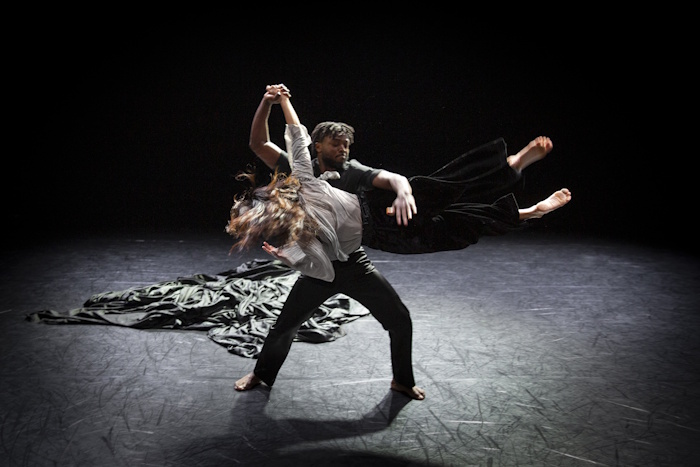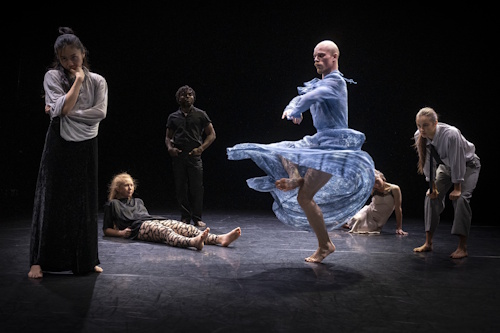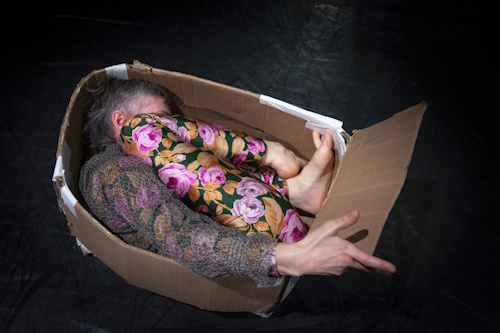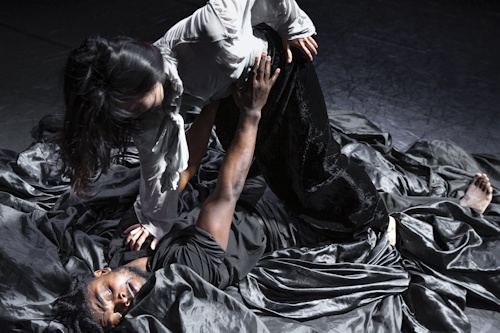Muffatwerk, Munich (as part of Tanzwerkstatt Europa)
August 5, 2025
Munich’s annual Tanzwerkstatt Europa festival, now in its 34th season, is a meeting hub for dance lovers of all sorts. From August 5–15, it offers performances by international and locally based choreographers; workshops every day for professionals and non-professionals, this year including two daily classes for golden agers over 60; lectures and talks; and ample opportunities for networking
This year, the festival was opened by Ultima Vez and Vim Vandekeybus who presented Void, which premiered in 2024 at the Royal Flemish Theater in Brussels. Vandekeybus explains in an interview that the piece is about individual experiences, family histories and characters living in their own worlds, but that also reveals their solitude and struggles, and through this invites us to engage with our own imagination.
We meet six characters, four women and two men, who each show us a traumatic experience, which they live within, through a mix of movement and text. Paola Taddeo sits in front of a drum. With all her willpower, she tries to play it with two drumsticks. But an invisible force draws her hands back every time she tries to hit it. Then, by accident, she hits her head, first with a drumstick then with her fist, the sound filling the stage and auditorium.
Later sitting on a suitcase, a man bombards her with sentences including, “Don’t be yourself, try to be normal, they don’t want you here,” which eventually leads her to attack a woman in the first row with a knife. Another dancer holds her back. It looked scary and very real.
Babette Verbeek is an old grumpy grandmother, who creeps into a cardboard box, closes it and for a long time just lies there, invisible. Later she walks as if crocked and with a cane. She complains about her granddaughter, who keeps kicking her legs or cane so that she falls. Her box mania continues throughout the piece, including attempting to get into boxes much too small for her.
Followed by a mass of thin, black, moving material Cola Ho Lok Yee enters. From under the cloth Hakim Abdou Mlanao appears. As they engage in a wild and violent relationship, it’s as if he has battered-husband syndrome. No matter how aggressive or brutal she is, no matter how much she throws him around, he keeps returning to her. Later, she reveals that she works as a prostitute and recounts what she feels about it while Mlanao turns into a mysterious man sitting all curled up and turned in on himself, withdrawn and unreachable for the others.
Adrian Thömmes, in a soft and gentle balletic solo, reveals that he went to New York, but the city was not for him, so he returned to his native Finland. He creates a strong contrast to Lotta Sandborgh, a powerhouse of anger who arrives with six plates, which she rolls like discs over the floor. The other dancers pick them up and hide them somewhere on their bodies but that doesn’t stop her walking around, smashing every single one with a hammer, the shards falling to the floor. In her native Swedish, she declares angrily, “I hate my stupid family, my parents always left me alone, now I have broken all the plates.”
So Void lays bare traumas in an incredibly physical way. Through their solos, each character expresses their loneliness and despair, although when they gather as a group, they give each other solace, comfort and support.
The dancers all show strong acting ability, but even more so, the work lives through their fabulous dancing. Sandborgh, Yee and Taddeo display a raw, aggressive and at times brutal male energy, which is rarely seen in choreography for women. Using the vocabulary of urban dance, they are incredibly strong. They threw their partners around in a way that you viscerally felt their hurt when they landed. Elsewhere, they moved with weightless elegance. When they rose from the floor, it was so smooth it looked like a movie being played backwards. Their few words and brilliant dancing together turned the performance into a physical experience.
The music and sound design by Belgian composer and music producer, Arthur Brouns, underscores every mood and emotional expression. Vandekeybus’ sets are partly a thin black cloth that is raised as a wall or used to hide somebody, and partly white material rolled out as walkways, perhaps indicating that the characters had found their path in life. Even though we only see indications of each individual’s story, all are easy to identify with, not because one’s own life is similar to that of the characters, but because all the experiences and emotions are so recognisable.




